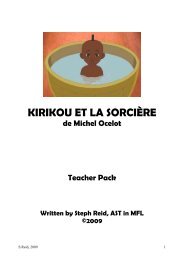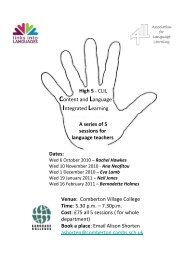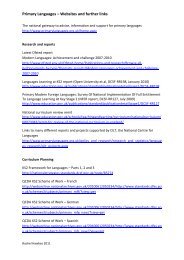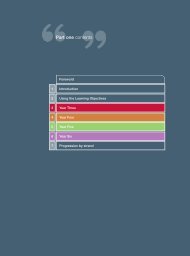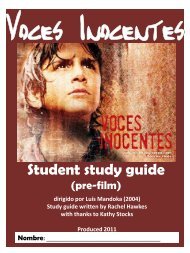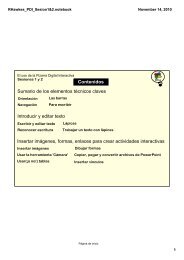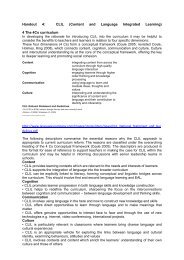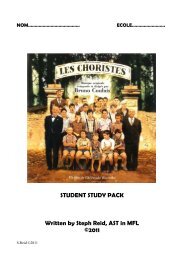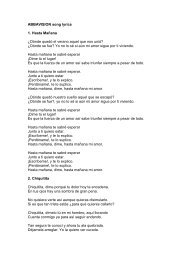Key Stage 3 Framework for languages ... - Rachel Hawkes
Key Stage 3 Framework for languages ... - Rachel Hawkes
Key Stage 3 Framework for languages ... - Rachel Hawkes
Create successful ePaper yourself
Turn your PDF publications into a flip-book with our unique Google optimized e-Paper software.
5 of 15 The National Strategies ⏐ Secondary<br />
The <strong>Key</strong> <strong>Stage</strong> 3 <strong>Framework</strong> <strong>for</strong> <strong>languages</strong>: glossary<br />
distractor<br />
In language learning, in activities such as gap filling where a bank of words is provided <strong>for</strong> filling<br />
the gaps, a few extra words may be added so as to raise the level of challenge.<br />
extended sentence<br />
An extended sentence is a sentence which has been made longer and perhaps more complex,<br />
<strong>for</strong> example through the addition of detail (e.g. adverbs, adjectives) or of clauses.<br />
'false friend'<br />
In language learning, a word which looks like a word in another language but does not mean the<br />
same thing. For example, the French un coin does not mean 'a coin' and the Spanish<br />
constipación does not mean 'constipation'.<br />
<strong>for</strong>mat<br />
The way in which a text is arranged or presented, <strong>for</strong> example as a book, leaflet, essay, video,<br />
audiotape. May also relate to the structure of the text, <strong>for</strong> example the use of headings and<br />
subheadings or diagrams/photographs with captions.<br />
function<br />
In the <strong>Framework</strong>, the term refers to the nature of a sentence or utterance in relation to its<br />
purpose: question, statement, request, invitation, description, expressing agreement or<br />
disagreement, expressing rights and duties, trying to convince someone, etc.<br />
genre<br />
This term refers to different types of writing, each with its own specific characteristics which<br />
relate to origin (legend/folk tale) or to the types of books individuals particularly choose to read<br />
(e.g. adventure, romance, science fiction).<br />
Texts with these specific features – often related to story elements, patterns of language,<br />
structure and vocabulary – may be described as belonging to a particular genre. These<br />
attributes are useful in discussing text and in supporting development of writing skills.<br />
Texts may operate at different levels, and so represent more than one genre; some will be<br />
combinations, <strong>for</strong> example historical romance.<br />
Text types are sometimes referred to as ‘genres’, <strong>for</strong> example narrative, argument, description,<br />
instruction.<br />
grapheme<br />
A written representation of a sound which may consist of one or more letters. For example, in<br />
English the phoneme s can be represented by the graphemes s, se, c, sc and ce as in sun,<br />
mouse, city, science.<br />
high-frequency word<br />
High-frequency words are likely to be met (in listening and reading) and needed (in speaking<br />
and writing) frequently in a wide range of contexts.<br />
00615-2009PDF-EN-27 © Crown copyright 2009



